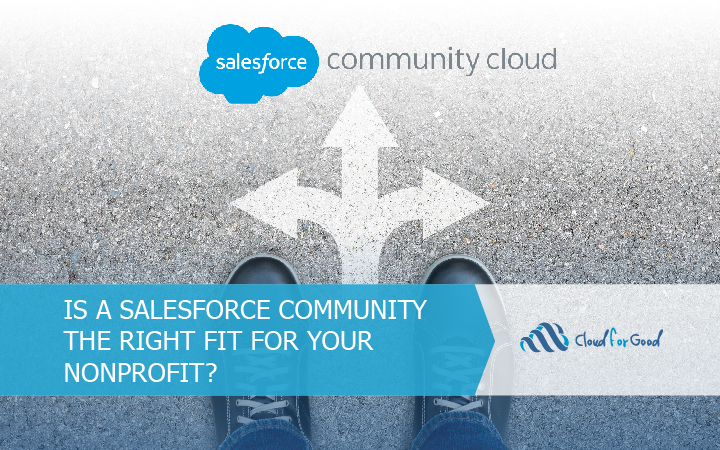If you can find value in sharing your Salesforce data with constituents, a Salesforce Community might be right for you! Salesforce Communities expand your database beyond your internal users and allow constituents to interact with each other and with your data in a controlled environment. You can control what records from Salesforce they can see and can moderate all conversations that happen in your Community.
How could a nonprofit use a Salesforce Community?
- Grants Management – constituents can apply for grants, submit reports, and view all their past submissions in one place.
- Customer Service – constituents can search your knowledge base, submit questions, and track the progress and history of their case submissions.
- Program Management – program participants can log in and view progress on Salesforce records pertaining to them.
- Partner Management – allow your partners or member organizations to manage their relationship with you and collaborate on Opportunities and Campaigns.
- Build connections – constituents can interact with each other in a community, ask and answer each others questions, and share files.
- And many more ways!
Do I Have to Be a Web Developer to Build One?
Not at all! True to the spirit of the Force.com platform, all the standard functionality is available to you to configure without seeing a single line of code. The Lightning Community Builder allows you to easily build Community pages with a drag and drop interface and brand your Community using logos and colors to match your website. With new functionality and features being added every release, a Salesforce Community template built with the Lightning Community Builder will make your portal look like a million bucks, even though you set it up in a single day!
A Salesforce Community is a long way from being a true website content management system, like WordPress or Drupa,l so you will still need to maintain your public facing organization website for new visitors. But once a constituent connects with you, a Community is a great way to keep them engaged with your work.
Community Editions and Licenses
Salesforce Communities include different editions and license levels that give you different functionalities at different price points. It is important to understand what each can do so you get the features your organization needs without paying for features you won’t be utilizing. Check out Salesforce’s page for the details, but here’s a quick overview.
Customer Community
This is the most common edition used by nonprofits that gives Community users access to Accounts, Contacts, Cases, and up to 10 custom objects related to the user’s Account or Contact.
Partner Community
Partner Communities are designed for large scale organizations that collaborate on sales/fundraising and marketing efforts with other partner organizations. This edition allows your partners to manage leads and gives them access to Opportunities, Quotes, Orders, Campaigns, and Reports.
Key Questions When Considering if a Community is Right for You
Will your constituents actually log in?
The primary value of a Community is building community from your constituents interacting with each other and engaging your constituents by showing them Salesforce records of interest to them. Neither of these value propositions pencil out if a large portion of your constituent’s do not use it. While a shiny new Community will make any nonprofit Marketing or IT Director proud, does it provide a value to your constituents? As with fundraising you have to ask – what is the hook and what is the personal connection that will motivate someone to log in and interact with your Community?
Are constituents just sending you data, or do they also need to view existing Salesforce records too?
If the communication is one way with data only going into Salesforce, online form tools such as FormAssembly, FormStack, or FastForms may be a better fit. The unique power of a Community is in showing existing Salesforce records back to users. If your constituents do in fact need to view existing records, then a Community might be right for you.
Do you primarily want a donor portal for showing donors their giving history and updating recurring payment information?
If so, a Community may not be the best fit for your organization. Only the highest level Community edition (Partner Community) gives your constituents access to their Opportunities, and it can be a bit costly if that is the only functionality that you need. Custom development can be implemented in a custom built Tabs+Visualforce Community to show Opportunities, but custom development comes with its own headaches and requires additional costs and maintenance, and a custom-built Tabs+Visualforce Community does not give you the same benefits and low maintenance of the new Lightning Community Builder.
Managing and updating recurring donations is handled by your payment processor and at this point, most do not integrate with a Salesforce Community. Chargent is currently the only native Salesforce payment app that integrates with a Salesforce Community. Currently, running a true donor portal on a Salesforce Community requires purchasing a Partner Community, along with Chargent for payment processing.
The Salesforce ecosystem continues to evolve and more donor portal options are likely to be available in the future. Cloud for Good is currently developing a Lightning Component that would allow a nonprofit to display all Opportunities from a constituent back to them in a Customer Community, thereby bypassing the requirement to purchase the more expensive Partner Portal licenses. Do you still have questions about a Salesforce Community for your organization? Contact us today to learn more about getting the most out of your Salesforce org.
You may also be interested in reading:





